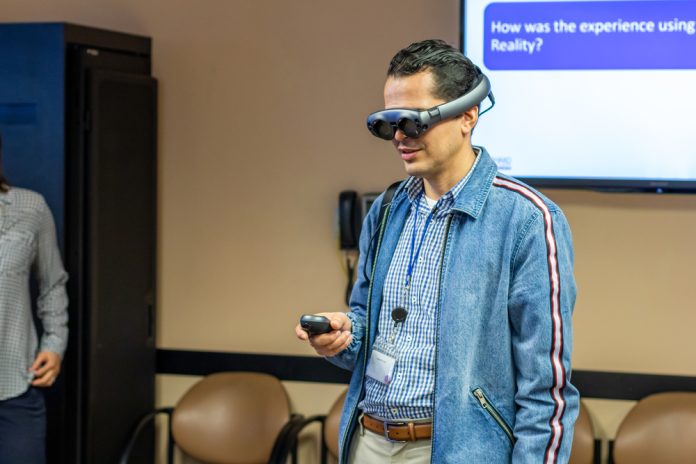
On Sarah’s first day at a Fortune 500 company, she sat in a sterile conference room, clicking through 47 slides about company values, while her future teammates remained strangers on the other side of a screen. Three months later, despite completing every module, she still felt disconnected from her role and team. Sound familiar?
Despite billions invested in onboarding programs, 33 percent of new hires quit within 90 days, with another 17 percent quitting within their first 30 days (Employee Cycle, 2025). Meanwhile, organizations with strong onboarding programs experience an 82 percent improvement in new hire retention (Brandon Hall Group, 2025).
For decades, companies have invested heavily in creating inspiring physical workspaces—beautiful offices in prime locations, thoughtfully designed collaboration spaces, and stunning campus environments. These investments pay dividends: Research shows that 69 percent of employees are more likely to stay with a company for three years if they experience excellent onboarding.
Yet today’s reality has fundamentally shifted. A McKinsey study found that 35 percent of employees can work remotely full-time, while 90 percent can work in hybrid arrangements. Gallup research reveals that 52 percent of employees prefer hybrid work, with many new hires beginning their careers remotely, never setting foot in those carefully designed offices during their crucial first weeks.
The 3 Fundamental Flaws
Traditional onboarding suffers from three gaps:
Isolation: New hires consume content alone, disconnected from people and context. Company culture becomes a solo slideshow, not a lived experience.
Abstraction: Complex processes and interpersonal dynamics are reduced to bullet points and flowcharts, stripping away nuances that make knowledge actionable. How do you teach “We value collaboration” through a slide deck?
Passive Learning: Onboarding treats employees as observers rather than participants, limiting retention and practical application. Culture isn’t something you learn about—it’s something you experience.
A Promising Path Forward with Spatial Computing
Enter spatial computing, which combines augmented reality (AR), virtual reality (VR), and mixed reality (MR) technologies to create immersive, three-dimensional digital experiences. This collection of technologies, also known as extended reality (XR), represents the next evolution in human-computer interaction, offering a compelling new modality for addressing these onboarding challenges.
Spatial computing creates three-dimensional interactive environments where digital content exists in physical space, enabling natural interaction through gestures, voice, and movement. Unlike traditional eLearning platforms that present information on flat screens, spatial computing creates environments where users can manipulate objects, navigate spaces, and interact with others overlaid on the physical world.
For remote hires, spatial computing has been shown to enhance retention through hands-on learning, with up to 80 percent retention reported one year post-training (Takeaway Reality, 2025). It also creates excitement through immersive experiences, resulting in a 76 percent increase in effectiveness compared to traditional methods (VirtualSpeech, 2025). More importantly, it allows new hires to experience company culture through interactive scenarios, rather than just reading about it in isolation.
Still, adoption comes with hurdles. It’s not just about putting slide decks into a 3D environment. True transformation requires rethinking content, engaging IT for device management and support, and preparing teams for a new way of learning. Success depends on thoughtful design, robust infrastructure, and cultural buy-in. Without that, novelty fades, and the potential is lost.
Envisioning the Future Through Hypothetical Transformation
Imagine a global manufacturing company with six-month technician training cycles. With spatial computing, new hires can practice without disrupting operations, exploring virtual replicas of equipment and collaborating with remote experts in real time. The result: faster ramp-up and sharper skills, transforming both employee experience and business outcomes.
This vision is already underway. Apple recently announced new enterprise features for the Apple Vision Pro, supporting companies that require high-fidelity design. Learning management system (LMS) providers, such as Cornerstone, are integrating immersive technology through collaborations with Meta. Meta’s integration with Microsoft 365 creates seamless workflows. At the same time, Google’s Android XR platform and Samsung’s Project Moohan headset will extend Google Workspace into spatial computing, enabling organizations to leverage their existing technology investments.
Yet many companies misstep by approaching spatial computing like any other technology purchase, focusing on hardware specifications and uploading old onboarding slide decks into immersive environments. The result is expensive virtual rooms that mirror ineffective methods. What works for tech-savvy teams often alienates broader user groups. IT departments face unfamiliar device management and support challenges, employees may view the experience as gimmicky, and managers struggle to assess impact using outdated metrics.
Getting It Right
Success requires systematic approaches addressing organizational, technical, and human factors simultaneously. This is where strategic partners and consulting teams become invaluable. They bring expertise in both learning design principles and deep technical understanding of spatial computing capabilities, helping you:
- Identify high-impact use cases
- Pilot programs with measurable ROI
- Build scalable frameworks
- Integrate technical implementation seamlessly into existing systems
- Co-create learning design and change management
Five Transformative Applications
- Remote team collaboration: New hires work alongside teammates in shared virtual spaces, building working relationships from day one.
- Complex system training: Explore 3D equipment, software interfaces, or facility layouts to understand spatial awareness.
- Safe simulations: Rehearse high-risk procedures, such as emergency responses, difficult conversations, and technical troubleshooting, without real-world consequences.
- On-the-job support: Digital or voice overlays guide employees through actual work tasks, reducing the time between completing training and performing independently.
- Cultural immersion: Navigate realistic scenarios that test company values in context.
Success metrics must evolve, too. Focus on time-to-productivity, knowledge retention at three months, behavioral change, peer integration, time/cost savings, and problem-solving skills under pressure, rather than completion rates and satisfaction scores. Also track system adoption, support load, and scalability teams to ensure long-term viability.
The ultimate goal isn’t just information transfer, but rather transformation through shared experience. With innovative design and implementation, spatial computing fosters understanding and relationships that help new hires feel confident, connected, and capable from the outset.
Sarah’s first day doesn’t have to involve sterile rooms and endless slides. With spatial computing, it could begin with a virtual tour guided by teammates, hands-on exploration of real challenges, and meaningful connections formed through shared experiences. But it will take more than just purchasing headsets to achieve this vision. It demands strategy, investment, and a willingness to reimagine what onboarding could be.
The technology exists. The opportunity is here. The question isn’t if spatial computing can transform onboarding, but whether organizations have the right partners and the confidence to do the work to make it a success.




